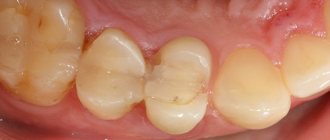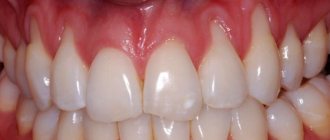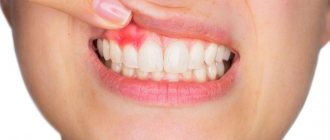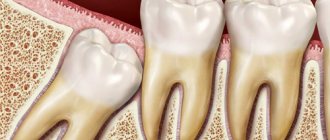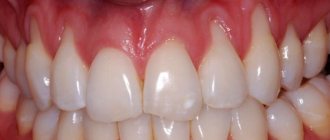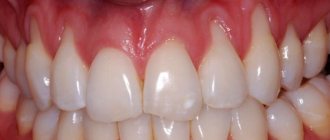Types of foreign bodies that can damage gums
Almost every person knows what a splinter is. Small pieces (wood, metal shavings, splinters, thorns, plant thorns, etc.) from time to time dig into the skin of the hands or other parts of the body. But a foreign object inside the gum can come as a complete surprise. If it is very small, it does not immediately provoke unpleasant sensations. Soreness and swelling appear only after inflammation develops.
Often a foreign body is found in a child’s gum. This is due to the fact that any objects that fall into his hands almost immediately end up in his mouth. If you do not remove embedded shavings, splinters or splinters, gingivitis will develop or a local gingival abscess will form.
The following items can damage your gums:
- chips from a toothpick or pencil;
- natural, plastic toothbrush bristles;
- pieces of plastic (from chewing plastic objects);
- husks from nuts and seeds;
- fish bones of different sizes;
- small fragments of filling material;
- metal shavings or pieces of dental instruments broken during dental treatment;
- crumbs of chipped dentin;
- other foreign bodies embedded in the gingival tissue at the time of injury.
Difficult case
Unfortunately, quite often patients come to the dental clinic too late, when the pathological process in the oral cavity has reached an advanced stage. This is why tooth extraction becomes a difficult task. This may be due to the presence of a strong inflammatory process, making visualization of the unit difficult. A fragment may remain in the hole only due to the complexity of the operation.
There are also cases when a tooth splits into several parts during extraction. As a result, it has to be removed piece by piece. If even one piece is left in the gum cavity, this can lead to serious consequences. To ensure that the tooth has been completely removed, your dentist may order an x-ray.
There are cases when the root of a unit splits into many small parts, that is, crumbles. This can occur as a result of serious injury, fracture, or due to the presence of acute inflammatory processes in the oral cavity, for example, cysts, phlegmon, osteomyetitis or abscesses. Often the root splits due to its strong mobility or incorrect location relative to other units.
Splinter in the gum
The oral cavity contains about 30 strains of microorganisms, represented by 750 types of microbes. A splinter in the gum is a foreign body that is a potential gateway for pathogenic microflora (viruses, bacteria, fungi) to enter the blood. It can cause 2 types of inflammation:
- local (around the wound);
- generalized (sepsis, secondary foci of infection in the body).
One of the most dangerous types of infection that can enter the body along with a foreign object is Clostridium tetani. This type of clostridia causes an acute infectious disease - tetanus, which is fatal in 60% of cases of infection in adults (90% in infants).
Abscess
Fish bone stuck in gum
Fish bones stuck inside soft periodontal tissues or the larynx are a common occurrence among fish lovers. Such foreign bodies can injure the oral cavity not only in adults, but also in children. They, as a rule, have sharp ends, so they penetrate not only into the mucous membrane, but also penetrate deeply into the muscle.
During an injection, the bone can damage the capillary wall, resulting in swelling and bruising. If, as a result of the puncture, nerve receptors are affected, then pain and paresthesia occurs in the area that is innervated by the damaged nerve. In severe cases, the motor functionality of the jaw may be impaired.
Large tooth surface
One of the most common situations is the presence of root fragments after extraction of wisdom teeth. This is explained by the fact that the procedure for removing eights in itself is very difficult due to the range of location of these units. In addition, a wisdom tooth usually has a rather massive root system and the crown part itself, so even an experienced technician cannot always cope with its extraction.
Even when removing chewing teeth, if there are certain anatomical problems in the oral cavity, complications may arise. Such teeth are quite difficult to visualize, so access to them is difficult.
Another possible scenario for the development of events during tooth extraction: the presence of a second affected unit nearby. When a tooth is removed, a fragment of a nearby tooth may accidentally fall into the resulting hole. There may be several reasons for this, for example, too much pressure from the instrument during crown surgery.
Symptoms of a foreign body in the gum
A foreign body inside the gums manifests itself in 2 types of symptoms: local, caused by mechanical irritation and inflammatory reaction, and general clinical, associated with intoxication of the body. General symptoms occur when a splinter remains in the tissue for a long time. The main signs of pathology are given below.
- What causes blood vessels in the eyes to burst and how to deal with this problem?
| Local reaction | Systemic manifestations |
|
|
Symptoms
After tooth extraction, the patient should be as attentive as possible to his well-being; if he feels unwell, he should see his doctor as soon as possible. The most common symptoms include: severe redness of the gum tissue, high body temperature even several days after the manipulation, the appearance of pain, purulent discharge, severe swelling, etc.
Of course, these symptoms are most often the norm, but only if their intensity gradually decreases. If the pain and swelling intensify, then this indicates the beginning of the inflammatory process.
It is important to understand that you should not examine the wound at the site of tooth extraction yourself; this can provoke a new infection and even displacement of the fragment into deeper layers of tissue. Only a competent specialist will be able to assess the condition of the patient’s oral cavity and prescribe the necessary studies and tests.
How to diagnose a splinter in the gum or a bone from a fish
If a person feels discomfort in the mouth while at home, then you can try to detect a foreign body inside the gums yourself. To do this, you will need a mirror and a flashlight (you can use the flashlight built into your mobile phone).
Procedure steps:
- Wash your hands with soap and treat them with an antiseptic.
- Direct a beam of light into the oral cavity.
- Use a mirror to examine the location of discomfort.
- After the examination, it is recommended to rinse your mouth with a disinfectant (Chlorhexidine).
It is not always possible to independently detect a foreign body in the mouth. In this case, you need to go to the dentist's office to see a doctor. The dentist will perform a more thorough visual examination. Sometimes an x-ray may be necessary.
Something sharp sticks out of gum after tooth extraction
“I had a tooth removed, and now there is a sharp piece of root sticking out of my gum. What should I do?"
This is a fairly common complaint from patients after tooth extraction. Most patients are sure that a piece of a poorly removed tooth root is sticking out of the gum. In fact, this also happens sometimes, of course, but extremely rarely. But almost always the matter is completely different.
The tooth is located in the bone in its own socket, which follows the shape of its roots. The tooth socket smoothly transitions into the tooth, thinning along the edge. When a tooth is removed, the socket rises on its own, without the tooth inside. Naturally, the edge of the socket becomes the highest point of the bone in a given place, and since it is very thin, it becomes sharp to the touch. This sharp edge is called exostosis.
The first time after removal, the patient does not really notice such things, because... first anesthesia, and then swelling hide this sharp edge. And then the swelling goes away, and the bone begins to stick out through the thin mucosa. And this is already becoming noticeable both on the tongue and on the finger, with which patients, despite the ban, still regularly touch the extraction site.
Plus, the chewing process on such a sharp bone becomes very painful. The patient immediately blames the doctor for everything and does not even want to go to him, hoping that the “tooth fragment” will soon come out on its own. But, you understand, this is not a fragment and it will never come out on its own.
Therefore, there are only two ways to solve the problem.
The first and most correct
Contact the doctor who removed the tooth. The doctor will administer a small anesthesia and, under this anesthesia, gently smooth down the sharp edge. Sometimes with the help of a bur, and sometimes simply by squeezing the edges of the hole.
In any case, there is no need to remove the bone too much, because... it is very valuable for future implantation (if it is planned, of course). It is enough to simply smooth the edge of the bone slightly so that it does not scratch.
If implantation is not planned, then there is no need to remove a lot of bone either, because Even for a simple removable denture, bone is a very valuable resource. The more bone, the better the denture will fit on the jaw, the more stable it will be when chewing, the longer it will last, and the less bone will settle under the denture over the years.
The second method is a little dubious
If the protrusion of the bone is not so sharp, does not cause severe pain, and you cannot get to the dentist, then you can try to exercise the gum a little over this exostosis.
Old surgeons advised patients to smooth out such bone protrusions several times a day with an ordinary teaspoon or tablespoon. On the one hand, they still become smaller over time as a result of tissue resorption and sedimentation, on the other hand, such a massage causes thickening of the mucous membrane in a given place and the bone through such a “callus” is felt much less.
It is not so easy to smooth the bone by hand and cause the mucous membrane to grow, but they say that sometimes it works.
How to remove bone from gum
If you manage to find a bone stuck in the gum, then removing it is not difficult. To do this, you need to take nail clippers or medical tweezers and treat them with an alcohol solution. Before manipulation, wash your hands with soap and running water. Using the tips of the tweezers, grasp the area of bone protruding above the surface and gently pull it out. The resulting wound is treated with an antiseptic.
Antiseptic Miramistin
Specialist actions
It doesn’t matter whether you turned for help to a professional dentist in a clinic or to an emergency room, the doctor’s algorithm of action is always the same. First of all, an external examination of the gums and teeth is required, and an x-ray examination is prescribed. X-ray helps determine the number of fragments, their location and depth.
Only after a preliminary examination can the doctor choose a specific technique for extracting fragments. After their removal, the hole must be washed with antiseptic solutions; if necessary, a drug with a powerful antibacterial effect is added to it. If fragments were found very close to the surface, they can be removed using a tool. If they are deep enough, then dissection of the gum tissue will be required.
Today, in all these cases, anesthesia is used, so the patient does not experience any discomfort. In rare cases, general anesthesia may be prescribed. It is very important to seek help immediately after identifying the first symptoms, this will allow you to remove the particles as quickly as possible and avoid serious complications in the future. Unfortunately, even the most highly qualified specialist is not immune from such situations, because everything depends on the complexity of the specific clinical picture and the individual characteristics of the human body.
previous post
What to do if a tooth grows from the roof of your mouth?
next entry
